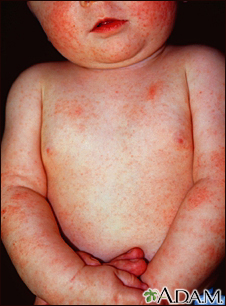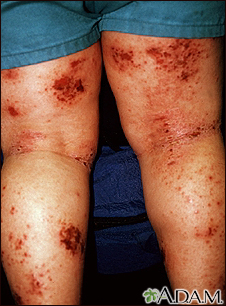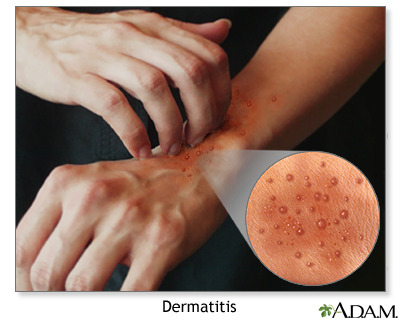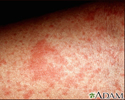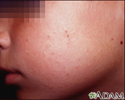Atopic dermatitis
Infantile eczema; Dermatitis - atopic; EczemaAtopic dermatitis is a long-term (chronic) skin disorder that involves scaly and itchy rashes. It is a type of eczema.
Other forms of dermatitis include:
- Contact dermatitis
Contact dermatitis
Contact dermatitis is a condition in which the skin becomes red, sore, or inflamed after direct contact with a substance.
 ImageRead Article Now Book Mark Article
ImageRead Article Now Book Mark Article - Dyshidrotic eczema
Dyshidrotic eczema
Pompholyx eczema is a condition in which small blisters develop on the hands and feet. The blisters are often itchy. Pompholyx comes from the Greek...
 ImageRead Article Now Book Mark Article
ImageRead Article Now Book Mark Article - Nummular eczema
Nummular eczema
Nummular eczema is a dermatitis (skin inflammation) in which itchy, coin-shaped spots or patches appear on the skin. The word nummular is Latin for ...
Read Article Now Book Mark Article - Seborrheic dermatitis
Seborrheic dermatitis
Seborrheic dermatitis is a common inflammatory skin condition. It causes flaky, white to yellowish scales to form on oily areas such as the scalp, f...
 ImageRead Article Now Book Mark Article
ImageRead Article Now Book Mark Article
Causes
Atopic dermatitis is due to a reaction in the skin. The reaction leads to ongoing itching, swelling and redness. People with atopic dermatitis may be more sensitive because their skin lacks specific proteins that maintain the skin's barrier to water.
Reaction
The immune response is how your body recognizes and defends itself against bacteria, viruses, and substances that appear foreign and harmful....

Atopic dermatitis is most common in infants. It may start as early as age 2 to 6 months. Many people outgrow it by early adulthood.
People with atopic dermatitis often have asthma or seasonal allergies. There is often a family history of allergies such as asthma, hay fever, or eczema. People with atopic dermatitis often test positive for allergy skin tests. However, atopic dermatitis is not caused by allergies.
Asthma
Asthma is a chronic disease that causes the airways of the lungs to swell and narrow. It leads to breathing difficulty such as wheezing, shortness o...

The following can make atopic dermatitis symptoms worse:
- Allergies to pollen, mold, dust mites, or animals
Allergies
An allergy is an immune response or reaction to substances that are usually not harmful.
 ImageRead Article Now Book Mark Article
ImageRead Article Now Book Mark Article - Cold and dry air in the winter
- Colds or the flu
Colds
The common cold most often causes a runny nose, nasal congestion, and sneezing. You may also have a sore throat, cough, headache, or other symptoms....
 ImageRead Article Now Book Mark Article
ImageRead Article Now Book Mark ArticleFlu
The flu (influenza) is a viral respiratory illness that causes fever, chills, runny nose, body aches, and cough. It spreads easily from person to pe...
 ImageRead Article Now Book Mark Article
ImageRead Article Now Book Mark Article - Contact with irritants and chemicals
- Contact with rough materials, such as wool
- Dry skin
Dry skin
Dry skin occurs when your skin loses too much water and oil. Dry skin is common and can affect anyone at any age. The medical term for dry skin is ...
 ImageRead Article Now Book Mark Article
ImageRead Article Now Book Mark Article - Drying out of the skin from taking frequent baths or showers and swimming very often
- Emotional stress
- Getting too hot or too cold, as well as sudden changes in temperature
- Perfumes or dyes added to skin lotions or soaps
Symptoms
Skin changes may include:
- Blisters with oozing and crusting
Blisters
A vesicle is a small fluid-filled blister on the skin.
 ImageRead Article Now Book Mark Article
ImageRead Article Now Book Mark Article - Dry skin all over the body, or areas of bumpy skin on the back of the arms and front of the thighs
- Ear discharge or bleeding
Ear discharge or bleeding
Ear discharge is drainage of blood, ear wax, pus, or fluid from the ear.
 ImageRead Article Now Book Mark Article
ImageRead Article Now Book Mark Article - Raw areas of the skin from scratching
- Skin color changes, such as more or less color than the normal skin tone
- Skin redness or inflammation around the blisters
- Thickened or leather-like areas, which can occur after long-term irritation and scratching
The type and location of the rash can depend on the age of the person:
- In children younger than age 2, the rash may begin on the face, scalp, hands, and feet. The rash is often itchy and forms blisters that ooze and crust over.
- In older children and adults, the rash is more often seen on the inside of the knees and elbow. It can also appear on the neck, hands, and feet.
- In adults, the rash may be limited to the hands, eyelids, or genitals.
- Rashes may occur anywhere on the body during a bad outbreak.
Intense itching is common. Itching may start even before the rash appears. Atopic dermatitis is often called the "itch that rashes" because the itching starts, and then the skin rash follows as a result of scratching.
Exams and Tests
Your health care provider will look at your skin and do a physical exam. You may need a skin biopsy to confirm the diagnosis or check for other causes of dry, itchy skin.
Skin biopsy
A skin lesion biopsy is when a small amount of skin is removed so it can be examined under a microscope. The skin is tested to look for skin conditi...

The diagnosis is based on:
- How your skin looks
- Your personal and family history
Allergy skin testing may be helpful for people with:
Allergy skin testing
Allergy skin tests are used to find out which substances cause a person to have an allergic reaction. These substances are called allergens....

- Hard-to-treat atopic dermatitis
- Other allergy symptoms
- Skin rashes that form only on certain areas of the body after exposure to a specific chemical
Skin rashes
Rashes involve changes in the color, feeling or texture of your skin.
 ImageRead Article Now Book Mark Article
ImageRead Article Now Book Mark Article
Your provider may order cultures for infection of the skin. If you have atopic dermatitis, you may get infections easily.
Cultures
A skin or nail culture is a laboratory test to look for and identify germs that cause problems with the skin or nails. It is called a mucosal culture...

Treatment
SKIN CARE AT HOME
Daily skin care may cut down on the need for medicines.
To help you avoid scratching your rash or skin:
- Use a moisturizer, topical steroid cream, or other medicine your provider prescribes.
- Take antihistamine medicines by mouth to reduce severe itching.
- Keep your fingernails cut short. Wear light gloves during sleep if nighttime scratching is a problem.
Keep your skin moist by using lotions, creams, or ointments (such as petroleum jelly) 2 to 3 times a day. Choose skin products that do not contain alcohol, scents, dyes, and other chemicals. A humidifier to keep home air moist will also help.
Avoid things that make symptoms worse, such as:
- Foods, such as eggs, that may cause an allergic reaction in a very young child (always talk to your provider first)
- Irritants, such as wool and lanolin
- Strong soaps or detergents, as well as chemicals and solvents
- Sudden changes in body temperature and stress, which may cause sweating
- Triggers that cause allergy symptoms
When washing or bathing:
- Expose your skin to water for as short a time as possible. Short, cooler baths are better than long, hot baths.
- Use gentle body washes and cleansers instead of regular soaps.
- Do not scrub or dry your skin too hard or for too long.
- Apply lubricating lotions, creams, or ointment to your skin while it is still damp after bathing. This will help trap moisture in your skin.
MEDICINES
At this time, allergy shots are not used to treat atopic dermatitis.
Antihistamines taken by mouth may help with itching or allergies. You can often buy these medicines without a prescription.
Atopic dermatitis is usually treated with medicines placed directly on the skin or scalp. These are called topical medicines:
- You will probably be prescribed a mild corticosteroid cream or ointment at first (such as hydrocortisone). You may need a stronger medicine if this does not work.
- Medicines called topical immunomodulators (TIMs) may be prescribed for anyone over 2 years old. Ask your provider about concerns over a possible cancer risk with the use of these medicines.
- Creams or ointments that contain coal tar or anthralin may be used for thickened areas.
- Barrier repair creams containing ceramides may be used.
Wet-wrap treatment with topical corticosteroids may help regulate the condition. But, it may lead to an infection.
Other treatments that may be used include:
- Antibiotic creams or pills if your skin is infected
- Medicines that suppress the immune system
- Targeted biologic medicines that are designed to affect parts of the immune system involved in atopic dermatitis
- Phototherapy, a treatment in which your skin is carefully exposed to ultraviolet (UV) light
- Short-term use of systemic steroids (steroids given by mouth or through a vein)
Outlook (Prognosis)
Atopic dermatitis can last a long time. You can help its symptoms by treating it, avoiding irritants, and by keeping your skin well-moisturized.
In children, the condition often starts to go away around age 5 to 6, but flare-ups will often occur. In adults, the problem is generally a long-term or returning condition.
Atopic dermatitis may be harder to regulate if it:
- Begins at an early age
- Involves a large amount of the body
- Occurs along with allergies and asthma
- Occurs in someone with a family history of eczema
Possible Complications
Complications of atopic dermatitis include:
- Infections of the skin caused by bacteria, fungi, or viruses
- Permanent scars
- Side effects from long-term use of medicines to regulate eczema
When to Contact a Medical Professional
Contact your provider if:
- Atopic dermatitis does not get better with home care
- Symptoms get worse or treatment does not work
- You have signs of infection (such as fever, redness, or pain)
Prevention
Children who are breastfed until age 4 months may be less likely to get atopic dermatitis.
If a child is not breastfed, using a formula that contains processed cow milk protein (called partially hydrolyzed formula) may cut down on the chances of developing atopic dermatitis.
References
American Academy of Dermatology Association website. Eczema types: atopic dermatitis overview. www.aad.org/public/diseases/eczema/types/atopic-dermatitis. Updated October 10, 2023. Accessed November 29, 2024.
Boguniewicz M, Leung DYM. Atopic dermatitis. In: Burks AW, Holgate ST, O'Hehir RE, et al, eds. Middleton's Allergy: Principles and Practice. 9th ed. Philadelphia, PA: Elsevier; 2020:chap 33.
Dinulos JGH. Atopic dermatitis. In: Dinulos JGH, ed. Habif's Clinical Dermatology. 7th ed. Philadelphia, PA: Elsevier; 2021:chap 5.
McAleer MA, Irvine AD. Atopic dermatitis. In: Bolognia JL, Schaffer JV, Cerroni L, eds. Dermatology. 5th ed. Philadelphia, PA: Elsevier; 2025:chap 12.
Moon M, Guerrero AM, Li X, Koch E, Gehris RP. Dermatology. In: Zitelli BJ, McIntire SC, Nowalk AJ, Garrison J, eds. Zitelli and Davis' Atlas of Pediatric Physical Diagnosis. 8th ed. Philadelphia, PA: Elsevier; 2023:chap 8.
Keratosis pilaris - close-up - illustration
Keratosis pilaris is seen most commonly during childhood and presents as small, rough, raised lesions that are called papules. These papules are described as spiny and keratotic and are typically skin colored. The papules are usually found on the outer surface of the upper arms and thighs, although it may occur elsewhere on the body. The roughness is accentuated by dry skin and the condition is often worse in the winter. It tends to be inherited and may be associated with atopic dermatitis.
Keratosis pilaris - close-up
illustration
Atopic dermatitis - illustration
The term dermatitis describes an inflammatory response of the skin, caused by contact with allergens or irritants, exposure to sunlight, or by poor circulation, even stress. An example of atopic dermatitis is eczema, an itchy rash that produces redness, blisters and scaling. AVOID SCRATCHING. Scratching the rash may spread the inflammation, lead to infection and even leave scars.
Atopic dermatitis
illustration
Atopy on the ankles - illustration
Atopic dermatitis occurs in individuals with tendencies towards allergies and who seem to have very sensitive skin. The persistent itching often encourages scratching, causing the skin to become raw or leathery. Here, the ankles and feet are affected.
Atopy on the ankles
illustration
Dermatitis - atopic in an infant - illustration
Atopic dermatitis is quite often seen on the cheeks of infants. It consists of red, scaling plaques that are diffusely scattered over the infant's body and face.
Dermatitis - atopic in an infant
illustration
Eczema, atopic - close-up - illustration
This view shows the red, scaly patches called plaques that are characteristic of atopic dermatitis.
Eczema, atopic - close-up
illustration
Dermatitis - atopic on a young girl's face - illustration
Lupus erythematosus often produces what is often called a butterfly rash or malar rash, seen here on a young girl's face. This is the characteristic appearance of the butterfly rash.
Dermatitis - atopic on a young girl's face
illustration
Keratosis pilaris on the cheek - illustration
Keratosis pilaris occurs most commonly during childhood and produces small, rough spots, called papules, that are typically the same color as the skin. They usually appear over the outer surface of the upper arms and thighs, but may also occur elsewhere on the body. Dry skin, especially during winter months, makes the condition worse. Keratosis pilaris tends to be inherited and may be associated with atopic dermatitis.
Keratosis pilaris on the cheek
illustration
Dermatitis - atopic on the legs - illustration
These red, scaly plaques on the legs are caused by an inherited allergic condition called atopic dermatitis. Many of these areas have been scratched until they are raw and infected, with the infection triggering and perpetuating the problem. In adults, atopic dermatitis frequently involves the body creases, such as inside the elbows and behind the knees.
Dermatitis - atopic on the legs
illustration
Hyperlinearity in atopic dermatitis - illustration
People with atopic dermatitis frequently have hyperlinearity, which is a thickening of the skin on the palms and soles with an increase in the number of lines in the skin. This characteristic is closely associated with genetic predisposition.
Hyperlinearity in atopic dermatitis
illustration
Keratosis pilaris - close-up - illustration
Keratosis pilaris is seen most commonly during childhood and presents as small, rough, raised lesions that are called papules. These papules are described as spiny and keratotic and are typically skin colored. The papules are usually found on the outer surface of the upper arms and thighs, although it may occur elsewhere on the body. The roughness is accentuated by dry skin and the condition is often worse in the winter. It tends to be inherited and may be associated with atopic dermatitis.
Keratosis pilaris - close-up
illustration
Atopic dermatitis - illustration
The term dermatitis describes an inflammatory response of the skin, caused by contact with allergens or irritants, exposure to sunlight, or by poor circulation, even stress. An example of atopic dermatitis is eczema, an itchy rash that produces redness, blisters and scaling. AVOID SCRATCHING. Scratching the rash may spread the inflammation, lead to infection and even leave scars.
Atopic dermatitis
illustration
Atopy on the ankles - illustration
Atopic dermatitis occurs in individuals with tendencies towards allergies and who seem to have very sensitive skin. The persistent itching often encourages scratching, causing the skin to become raw or leathery. Here, the ankles and feet are affected.
Atopy on the ankles
illustration
Dermatitis - atopic in an infant - illustration
Atopic dermatitis is quite often seen on the cheeks of infants. It consists of red, scaling plaques that are diffusely scattered over the infant's body and face.
Dermatitis - atopic in an infant
illustration
Eczema, atopic - close-up - illustration
This view shows the red, scaly patches called plaques that are characteristic of atopic dermatitis.
Eczema, atopic - close-up
illustration
Dermatitis - atopic on a young girl's face - illustration
Lupus erythematosus often produces what is often called a butterfly rash or malar rash, seen here on a young girl's face. This is the characteristic appearance of the butterfly rash.
Dermatitis - atopic on a young girl's face
illustration
Keratosis pilaris on the cheek - illustration
Keratosis pilaris occurs most commonly during childhood and produces small, rough spots, called papules, that are typically the same color as the skin. They usually appear over the outer surface of the upper arms and thighs, but may also occur elsewhere on the body. Dry skin, especially during winter months, makes the condition worse. Keratosis pilaris tends to be inherited and may be associated with atopic dermatitis.
Keratosis pilaris on the cheek
illustration
Dermatitis - atopic on the legs - illustration
These red, scaly plaques on the legs are caused by an inherited allergic condition called atopic dermatitis. Many of these areas have been scratched until they are raw and infected, with the infection triggering and perpetuating the problem. In adults, atopic dermatitis frequently involves the body creases, such as inside the elbows and behind the knees.
Dermatitis - atopic on the legs
illustration
Hyperlinearity in atopic dermatitis - illustration
People with atopic dermatitis frequently have hyperlinearity, which is a thickening of the skin on the palms and soles with an increase in the number of lines in the skin. This characteristic is closely associated with genetic predisposition.
Hyperlinearity in atopic dermatitis
illustration
Review Date: 10/13/2024
Reviewed By: Ramin Fathi, MD, FAAD, Director, Phoenix Surgical Dermatology Group, Phoenix, AZ. Also reviewed by David C. Dugdale, MD, Medical Director, Brenda Conaway, Editorial Director, and the A.D.A.M. Editorial team.

